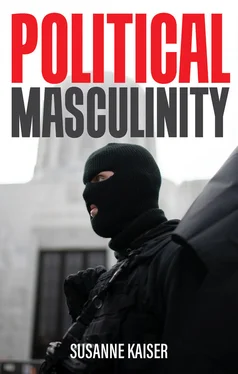Library of Congress Control Number: 2021948547
The publisher has used its best endeavours to ensure that the URLs for external websites referred to in this book are correct and active at the time of going to press.
However, the publisher has no responsibility for the websites and can make no guarantee that a site will remain live or that the content is or will remain appropriate.
Every effort has been made to trace all copyright holders, but if any have been overlooked the publisher will be pleased to include any necessary credits in any subsequent reprint or edition.
For further information on Polity, visit our website:
politybooks.com
For Jakob, Daniel and Luca
I would like to thank Jakob Krais, Renata Jakovac, Laurence Erdur, Jule Govrin, Elise Landschek and Marion Kaiser for reading my manuscript so closely, honestly critiquing my arguments, and intensely discussing the topics at hand. Without their help, the book would not be what it is. My gratitude also extends to my editor, Christian Heilbronn, who dug deeply into the material presented here and put his heart and soul into the text.
The images that circulated around the world during the final days of the Trump era will long remain in the collective memory: images of enraged white men storming the Capitol Building and rioting in the chambers of Congress and in the offices of elected officials, all while the cameras were rolling. Five people died, and numerous others were injured. These images are iconic because they stand for so much of what had become the political programme during the presidency of Donald Trump. The footage and photographs of the events at the Capitol provide, in a condensed form, a scathing testimony to the times.
It is hardly a coincidence that the vast majority of the rioters were men. Moreover, they were men playacting as men, complete with paramilitary garb: in the photographs, we see militiamen in full battle gear, including bulletproof vests, automatic weapons and combat helmets. In addition, we also see a topless shamanistic warrior with a pelt around his waist and a horn helmet on his head – all while brandishing a spear. We also see QAnon supporters, Proud Boys and members of the Boogaloo movement wearing Hawaiian shirts either over or under their bulletproof vests. Many of these men are carrying Confederate flags, waving around Nazi iconography or wearing gas masks familiar from the world wars. The wackier the outfit, the clearer it is to see just how overexaggerated the militant ideal of masculinity has become. Because it was such a central feature of politics during the Trump era, militant masculinity has become a caricature.
All of these men have one thing in common: they are at war. Against what or whom, exactly, is made explicitly clear in the images themselves, and especially by those from the office of Nancy Pelosi. It is no coincidence that, of all places, the workplace of the highest-ranking American woman then in office stood at the centre of the riots. In the images, the men are pictured staging a denigration of Pelosi for the press photographers: one man, who prototypically embodies the stereotype of the ‘old white man’, stood in his heavy boots on Pelosi’s desk – on the centre, that is, of her political work. This is a typically masculine gesture of disrespect that could have been taken straight out of a cowboy movie. Gallows were erected in front of the Capitol Building, and it was reported that they were set up for Pelosi. Whether the intention was really to hang the female politician or merely to stage a threat, we’ll never know. The message, however, was clear: women should be removed from political office, with force if necessary. These men were wildly determined to retake what they thought had been stolen from them: ‘their’ votes, ‘their’ country, ‘their’ privileges.
Donald Trump was the first president to engage in identity politics with white masculinity, the first president of a Western nation whom an authoritarian backlash had helped to put into office. The so-called ‘storming’ of the Capitol was merely the climax of a development that we became used to seeing during his time in office – namely, the phenomenon of armed men rampaging around in public. This backlash is gendered; it is masculine, as I will show in this book. It is a reaction to the fact that women and other political minorities have become much more visible over the last twenty years, and have been fighting for rights and spaces like never before. The internet made this possible. Without the ‘digital revolution’ and the counter-public of social media, a movement such as #Metoo would have been unthinkable. This movement brought to light an unexpected and eruptive amount of potential and had a decisive influence on the patriarchal structures of the analogue world. It still, in fact, continues to influence the media, the economy, society and politics. Yet a formidable opposition has risen up against this shift towards more equal rights. By all available means, the actors involved in this authoritarian backlash seek to resist, throughout the West, the renegotiation and redistribution of privileges that many people have simply because they are male, white and hetero-cis.
This reactionary backlash movement existed before Trump – again, it helped to put him into the most influential political office in the world. Also, Trump’s political downfall was not brought about, for instance, by the fact that images of men terrorizing the public had become an almost daily occurrence during his time in office. Trump’s fall in popularity among certain sectors of the population was in fact brought about by the Covid pandemic. For he responded to this, too, with the same political programme of toxic masculinity, the heart of which consisted of lying, suppressing information and downplaying things. When Trump himself ultimately became infected with the virus, his political response was to dismiss the illness as being too weak for really strong men, and this message was heard loud and clear by his core supporters. An article in Mother Jones described how Trump staged this masculinity: still recovering and still contagious, Trump climbed up the stairs to the White House balcony, ripped off his mask in a pathetic gesture, and gave a salute to the presidential helicopter as it flew away in the direction of the Washington Monument. Later, a propaganda video of the scene was uploaded to Trump’s Twitter account. The video is set to an instrumental version of the song ‘Believe’, which appears on an album titled ‘Epic Male Songs’. 1
A virus, however, cannot simply be gaslighted away; it will remain and spread unless measures are taken against it. The coronavirus demonstrated the limits of Trump’s politics of toxic masculinity. The political gestures of ‘strongmen’ such as Trump, Bolsonaro or Putin – and the male domination associated with these figures – have come under especially strong criticism during the pandemic and have increasingly been regarded as the negative foil to the leadership that women heads of state have shown during the crisis. 2Even the consulting firm McKinsey stated in a paper that the old leadership style was in a state of crisis. Today’s leaders, according to the authors of this paper, need to be able to work in teams, display deliberate calm and demonstrate empathy in order to manage new global challenges such as the pandemic. 3
This has not been without consequences. Whereas the mainstream media praised women leadership, an additional discourse also emerged – a counter-discourse: in the semi-public spheres of social media, comment sections and internet forums, there has been an outpouring of frustration about women in power. When the British writer Matt Haig posted the picture of the seven women heads of state on Instagram, together with the remark ‘Time for women to lead the world’, this quickly led to comments such as: ‘Incel tsunami incoming’. 4With this reference to an incoming tsunami of incels, the commenter was simply anticipating what typically happens whenever something is posted about women who succeed in public domains, which are still regarded by many as domains for men: the post is mobbed, ridiculed, threatened, hated, and sometimes these threats are even translated into action, as demonstrated by the many attacks on women in recent years.
Читать дальше












